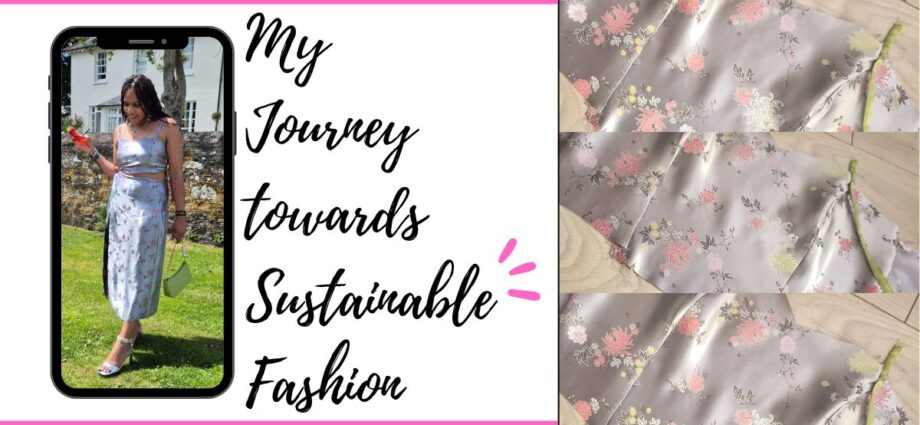There’s a particular kind of panic that hits when a wedding invite arrives. For years, that invitation became permission, no! An excuse to buy something new. Something that would announce: I’ve arrived, transformed, evolved.
And then, after the night ended and the photos were posted, that outfit would join the quiet graveyard of “special occasion” garments. Waiting for a second life that rarely came.
“Most wardrobes are archives of forgotten selves.” Wednesday
1. The Full Wardrobe Paradox
When I look at my closet now, I see more than fabric and thread. I see the sediment of consumption — layers of identity experiments, fleeting moods, and aspirational selves.
Tansy Hoskins, in The Anti-Capitalist Book of Fashion, describes fashion as an “industry built on overproduction and psychological manipulation,” where our sense of self-worth becomes tangled in cycles of constant renewal. Fast fashion doesn’t just fill our wardrobes, it fills the emotional spaces where meaning should live.
Kate Fletcher calls this the “paradox of abundance”: our closets overflow, yet we feel we have nothing to wear. The clothes become noise, a cluttered landscape of what we once desired but no longer recognise.
In my own research, I’ve come to see full wardrobes as emotional mirrors. They reflect our social and economic conditioning, the idea that visibility equals value. Mair reminds us that sustainability is a cultural shift, not a consumer trend. It’s about unlearning the reflex to express change through purchase.
So when I stare at those unworn dresses, I see more than fashion fatigue, I can see the ghost of capitalism whispering, you’re never enough.


2. The Rental Mirage
When I started rejecting fast fashion, rentals seemed like the perfect in-between. Ethical indulgence. A circular fix for linear habits.
But reality was less poetic. I wanted to touch the fabrics, feel their weight, try them on, not scroll through thumbnails and pray for fit. The sustainability pitch quickly turned into another form of labour.
Barber (2018) writes that sustainable fashion often disguises the same consumerist logic in new packaging — novelty disguised as virtue. Renting doesn’t really challenge the craving for “newness”; it simply outsources it.
And emotionally, I still felt the same pulse: that little dopamine hit of new outfit, new me. The difference was that it came wrapped in the language of “responsibility.”
It made me question how often we mistake sustainability for self-redemption.
3. The Fabric Cupboard Revelation
Three days before my cousin’s wedding, in a quiet state of panic, I opened my fabric cupboard, the unspoken archive of all my “one-day” projects.
There it was: a piece of Chinese silk I’d bought nearly ten years ago. Soft, luminous, a little forgotten.
That fabric became my saviour. Its beauty demanded simplicity, which suited my lack of time. I designed a two-piece, easy to sew, easy to rewear.
And for the first time in years, I felt something I hadn’t felt in fashion for a long time: connection.
Mair writes about the “slow intimacy of making,” how creation re-establishes a sensory bond that consumption severs. In that short burst of sewing, I realised sustainability wasn’t only about where we buy , but it’s about how we relate. The act of making turned panic into process.
4. Rewearing as Resistance
When I wore that outfit at the wedding and later restyled the skirt with a t-shirt and trainers, it wasn’t about proving my principles. It was about continuity.
The rewear felt fuller, more personal, more alive.
“There was something more wholesome rewearing something I had made, rather than a dress I had bought from Zara.”
Hoskins might call this a micro-act of rebellion and a refusal to participate in the constant churn of disposability. And she’s right: there’s quiet power in taking ownership of your own aesthetic rhythm.
Barber argues that true sustainability begins “when we stop outsourcing our sense of self to the market.”
5. Learning to Mend the Self
Every stitch in that outfit became an education. Not in fashion, but in patience.
It taught me that repair isn’t just practical but, it’s also psychological.
Fletcher reminds us that the joy of sustainable fashion lies in “deepening our engagement with what we already have.” And maybe that’s what learning through fashion really is: understanding that care, time, and rewear are not restrictions but creative freedoms. To mend and re-wear our clothes is to mend our sense of self.

Closing Reflection
So yes this is a “late post.”
But perhaps lateness is its own kind of activism. A refusal to perform urgency in a world addicted to speed.
My wardrobe is still imperfect, still crowded, still whispering memories of who I’ve been.
But when I wear that silk skirt, I wear time, effort, and story.
Because sustainability isn’t about saving the planet alone.
It’s about learning to save ourselves from the need to be constantly new.

